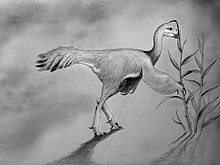Leptorhynchos gaddisi
| Leptorhynchos | |
|---|---|

| |
| Life reconstruction of L. gaddisi by one of the authors of its description | |
| Scientific classification | |
| Domain: | Eukaryota |
| Kingdom: | Animalia |
| Phylum: | Chordata |
| Clade: | Dinosauria |
| Clade: | Saurischia |
| Clade: | Theropoda |
| Clade: | †Oviraptorosauria |
| Superfamily: | †Caenagnathoidea |
| Family: | †Caenagnathidae |
| Genus: | †Leptorhynchos Longrich et al., 2013 |
| Type species | |
| †Leptorhynchos gaddisi Longrich et al., 2013
| |
| Other species | |
Leptorhynchos (
Discovery

Leptorhynchos was named in 2013 by Nick Longrich, Ken Barnes, Scott Clark, and Larry Millar. In their description, they conducted a specimen-level review of North American caenagnathids in an attempt to resolve the perennial taxonomic confusion surrounding the group. This included the type specimens of Caenagnathus, Chirostenotes, and Hagryphus as well as specimens of more ambiguous affinities such as ROM 781, which was previously named as a species of Ornithomimus. Their analysis also included the specimen TMM 45920-1, which would later be designated as the holotype of Leptorhynchos gaddisi.[2][3]
The results of Longrich and colleagues' analysis was the naming of the new genus, Leptorhynchos, and the assignment of "Ornithomimus" elegans (specimen ROM 781) as a second species in that genus. Several other specimens, such as MOR 1107, were referred to the genus but not assigned to a particular species. Their description contained an initial and then a revised diagnosis of the genus and both species.[2][3] Remains of other small caenagnathids from Laramidia discovered in the Hell Creek and Scollard formations have variously been attributed to the genus, but without being assigned to either of the named species.
Description
Species
- Leptorhynchos gaddisi
L. gaddisi was named as the type species of the new genus by Longrich and colleagues. They based the diagnosis of this species on the anteriorly-projected beak tip, rounded ventral margin of the
- "Leptorhynchos" elegans

The fossil specimen ROM 781 was described in 1933 as a new species of the genus
- Leptorhynchos sp.

In their description of the genus, Longrich and colleagues referred the specimen MOR 1107 (part of a
Skeleton
The
The dentaries of the holotype were fully fused with no visible sutures, which suggest that the animal was fully mature when it died and the small size of the specimen is not the result of
The referred specimens from the Aguja Formation are tentatively assigned to this taxon. They include a single partial vertebra, two partial metatarsals, and a pedal ungual. The vertebra is unremarkable with twin
Classification

In their description of the holotype, Longrich and colleagues conducted a phylogenetic analysis. Their analysis used the dataset of Longrich's earlier publication in 2010 with several new taxa added for a total of 28 taxa coded for 205 characters. Their data set also included recent information about
Longrich and colleagues broadly determined that most
For specimens which do not contain the relevant diagnostic characters or any indication of their ontogenetic age, they have been assigned to existing taxa according to size and locality. Longrich and colleagues note that this approach has shortcomings, but they argue that the ecological abundance of adult animals in any ecosystem means that most fossilized animals will be adults anyways, which they suggest is sufficient for the purposes of their analysis. A consensus of the 116 most parsimonious trees in their analysis is shown below.[2]
| Oviraptorosauria |
| |||||||||||||||||||||||||||||||||||||||||||||||||||||||||||||||||||||||||||||||||
The most recent
| Caenagnathoidea |
| ||||||||||||||||||||||||||||||||||||||||||||||||||||||
Paleoecology


Paleoenvironment
The only definite remains of Leptorhynchos have been recovered from the Upper Shale Member of the
Contemporary fauna
A wide variety of
A wide variety of
Dinosaurs are the largest animals found in the Aguja Formation, and the taxa found in these rocks is broadly similar to contemporaneous faunal assemblages in the
See also
- 2013 in paleontology
- Cretaceous land vertebrate ages
- Laramidia
- List of vertebrate fauna of the Maastrichtian stage
- Timeline of oviraptorosaur research
References
- PMID 29166406.
- ^ S2CID 128444961.
- ^ S2CID 128898931.
- ISBN 978-0691180311.
- ^ ISSN 2292-1389.
- ^ PMC 10807829.
- S2CID 261779584.
- S2CID 73689603.
- ^ Stein, Walter W. (2019). "TAKING COUNT: A Census of Dinosaur Fossils Recovered From the Hell Creek and Lance Formations (Maastrichtian)" (PDF). The Journal of Paleontological Sciences. 8: 1–42.
- .
- ^ PMID 30726228.
- PMC 4489096.
- ^ Mannion, Philip (2013). "Terlingua area (Cretaceous of the United States); Also known as TMM 45920". The Paleobiology Database.
Where: Brewster County, Texas
- ^ .
- .
- ^ .
- S2CID 86519841.
- S2CID 220412294.
- ^ S2CID 128555861.
- S2CID 253470207.
- S2CID 88907183.
- PMID 27073969.
- .
- ^ West, Bryanna (2020). Campanian-Maastrictian Ankylosaurs of West Texas (PDF) (Thesis). Texas Tech University.
- ISBN 0-253-33907-3.
- ^ Sullivan, R.M., and Lucas, S.G. 2006. "The Kirtlandian land-vertebrate "age" – faunal composition, temporal position and biostratigraphic correlation in the nonmarine Upper Cretaceous of western North America[permanent dead link]." New Mexico Museum of Natural History and Science, Bulletin 35:7-29.
- JSTOR 1306931.

